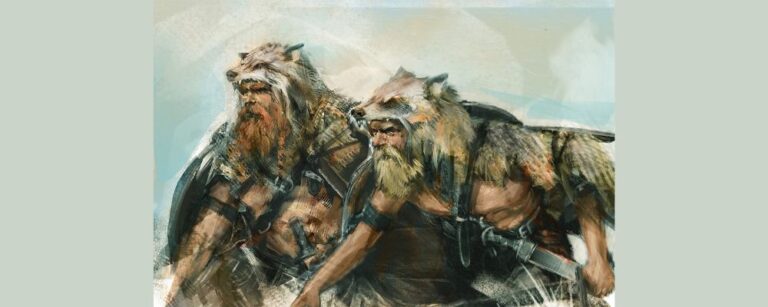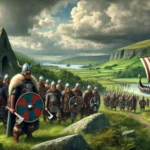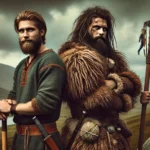All Viking warriors were known by their neighbors to be strong, ferocious, and bloodthirsty. But among the Vikings themselves, there was an elite group of warriors known as the Berserkers. They were believed to fight with the ferocity of wild animals and to be immune to steel and fire.
But did these warriors really exist, or were they just a myth?

What is a Berserker?
According to legend, Berserker warriors were a religious order who underwent rituals to commune with the spirit of wild animals before going into battle.
The animal most closely associated with the Berserkers is the bear. Berserker means “bear coat”. But there were also Ulfhednar, “wolf coats”, and Jofurr, “boar coats”. What is important is that these are wild animals native to the region and known to fight ferociously.
The warriors were part of a kind of religious order in which they learned rituals to commune with the spirit of the animal before going into battle to adopt its ferocious spirit.
The men would then enter battle in a frenzy, displaying great strength and courage, but also lose their senses to an extent. They are often described as doing things such as gnawing on their own shields to control their bloodlust while waiting for the battle cry.

They were considered all but untouchable while fighting in this state. It was believed that they could not be hurt by steel or fire while in their frenzy. But importantly, they also went into battle naked or using furs rather than armor. This may have alarmed their opponents as it shows an extreme level of fearlessness.
But after the frenzy died down, which could last hours or days, they were in a weakened state and would need to rejuvenate themselves.
That they seem to have been part of a special cult is reinforced by stories of them observing special rules. For example, one Berserker had to postpone a single combat challenge to observe ritual days around Yule. When Berserkers died, they were laid out on the skin of their animals during their funerary proceedings.
They are sometimes described as Odin’s special warriors, and it would make sense if their cult was focused on the god of war. The Valkyries, the divine shieldmaidens that help Odin take the bravest warriors to Ragnarok, are sometimes represented as their spirit wives.
While most readers interpret stories of the Berserkers as the warriors taking on the ferocity of the animals, there are some accounts that suggest that they transformed into the animal itself, literally becoming a bear or a wolf. This is known as hamask, “to change form”.
Attestations of Berserker Warriors
Berserker warriors are mentioned fairly often in the surviving sagas, and there is also good evidence that they have been around since early German times.
Trajan’s column in Dacia, which was built in the first century AD, shows German warriors wearing the skins and heads of both bears and wolves. German shields and standards captured by the Romans also show warriors using wolf skins.
A 5th century golden horn from Mogeltonder shows naked warriors in horned headdresses, which is the way that Berserkers often seem to be represented.

In the late 9th century, Thorbjorn Hornklofi describes King Harald Fairhair of Norway as having a guard of wolf warriors that wore pelts rather than mail when they went into battle.
The saga of Hrolf Kraki claims that Bodvar Bjarki literally shapeshifted into a bear to fight at the front of King Hrolf Kraki’s army. The following is a translation of his description of the warriors.
I’ll As of the berserks, you tasters of blood,
Those intrepid heroes, how are they treated,
Those who wade out into battle?
Wolf-skinned they are called. In battle
They bear bloody shields.
Red with blood are their spears when they come to fight.
They form a closed group.
The prince in his wisdom puts trust in such men
Who hack through enemy shields.
The “tasters of blood” are not the warriors, but rather the ravens of Odin that circle the battlefield, reinforcing the connection between the Berserkers and the All-Father.
It is the Svarfaela Saga that tells the story of a Berserker postponing a single battle until three days after Yule due to his personal religious observances.
According to Egil’s Sage, a group of Vikings that went to King Harald to tell him about the death of one of his family members were strong and had an “uncanny” presence that made them look more like trolls than humans. Many interpreters believe that these must have been Berserkers.
According to the Byzantine Emperor Constantine VII in the 10th century, some of his Varangian guard, elite Viking warriors in his service, engaged in something known as the Gothic dance wearing animal skins and masks. He might be describing a Berserker ritual.
In the 13th century, Snorri Sturluson also described “Berserkergang”hen.
Odin’s men rushed forwards without armor, were as mad as dogs or wolves, but their shields, and were strong as bears or wild oxen, and killed people at a blog, but neither fire nor iron told upon them.
Some bronze-cast dies found at Torslunda in Oland in Sweden seem to reference the Berserker rituals. One shows a dancing man wearing a horned headdress and another man carrying a spear and using a wolf’s skin. This may represent a ritual of communing with the wolf.

But were the Berserker’s Real?
The ubiquitous mention of the Berserkers in the surviving sources suggests that the legend was based on something. Even if the Vikings did not have warriors that could shapeshift into bears or wolves, or that were immune to fire and steel, they may well have had warriors that worked themselves into a great frenzy to be stronger and more daring in battle.
Some scholars suggest that the rituals that they engaged in to achieve this state may have involved the consumption of drugs, such as hallucinogenic mushrooms.
This theory has been lent support by the discovery of Henbane seeds (Hyoscyamus niger) in the grave of a Viking warrior unearthed in Denmark. Henbane is known to cause violent behavior, increase strength, and generally cause a person to lose control of themselves in a way not too dissimilar from that described of the Berserkers.
So, while there may be a lot of myths around the idea of the Berserkers, they certainly seem to have existed in Viking times.
Berserkers in Vikings Valhalla
Drawing on Viking history and legend, the History Channel has included Berserkers in their Vikings: Valhalla series. But they do seem to have to include them in the most unusual way. It is not the pagan Vikings who follow Berserker practices, but Jarl Kare and his men, who are looking to eradicate the old religion in Scandinavia.
This seems extremely unlikely. While other Viking warriors found a place for themselves within Christianizing Scandinavia, the Church did not support the use of drugs in battle. As Viking communities began to convert to Christianity Berserkers were outlawed, starting in Norway in 1015. The practice is also clearly outlawed in the medieval Icelandic law code known as the Gragas.
Considering the close connection between the Berserkers and Odin, this part of the Vikings: Valhalla series seems very out of step with historic possibilities.

What does it mean to go Berserk today?
The idea of going berserk still exists among modern Vikings, but it has taken on a new meaning. Rather than losing control and fighting with the ferocity of a bear, it refers to the ability to transform yourself by finding inner strength that does not always feel accessible.
Modern practitioners of Asatru will commune with the spirit of the bear or wolf to help them access that strength in times of extreme challenge.
But what do you think? Would you like to go berserk?








